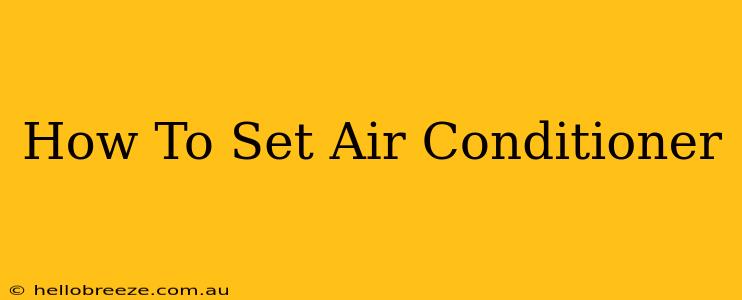Setting your air conditioner correctly is crucial for both your comfort and your energy bill. This guide will walk you through the process, explaining different settings and how to optimize them for your specific needs and climate.
Understanding Your Air Conditioner's Settings
Before diving into specific settings, let's familiarize ourselves with the common controls you'll find on most air conditioners:
- Temperature Setting: This is the most basic setting, controlling the desired temperature in your space.
- Fan Speed: Most units offer settings like "Auto," "Low," "Medium," and "High." "Auto" automatically adjusts the fan speed based on the temperature difference.
- Mode: Typical modes include "Cool," "Heat," "Fan Only," and "Auto." "Auto" often switches between cooling and heating based on the set temperature.
- Swing/Directional Vents: These control the direction of the airflow, allowing you to customize where the cool air is directed.
- Timer: Many AC units have a timer function, allowing you to schedule when the unit turns on and off.
- Energy Saving Mode (ECO Mode): This mode often limits the compressor's operation to reduce energy consumption, potentially at the cost of slightly slower cooling.
Setting Your Air Conditioner for Maximum Efficiency
Optimizing your air conditioner settings goes beyond simply setting the temperature. Here's how to achieve the best results:
1. Choosing the Right Temperature
The ideal temperature setting depends on personal preference and the climate, but 72-78°F (22-25°C) is generally recommended for energy efficiency and comfort. Every degree lower will significantly increase energy consumption. Consider increasing the temperature slightly while you are away from home.
2. Utilizing the Fan Speed Wisely
- Auto Mode: This is usually the most energy-efficient option, as it adjusts the fan speed to match cooling needs.
- Low or Medium: If you prefer a gentler breeze, select a lower fan speed. High fan speed may not necessarily cool faster, and it consumes more energy.
3. Leveraging the Timer Function
Program your AC unit to turn off when you're not at home or asleep, saving significant energy. Smart thermostats offer advanced scheduling capabilities.
4. Proper Airflow Management
Ensure that air vents are not obstructed by furniture or curtains. This allows for proper air circulation and efficient cooling. Experiment with the swing function to distribute cool air evenly throughout the room.
5. Regular Maintenance
Regular maintenance, including filter cleaning and professional servicing, keeps your air conditioner running at peak efficiency and prolongs its lifespan. A dirty filter restricts airflow, reducing cooling efficiency and increasing energy consumption.
6. Consider Energy Saving Mode
ECO mode can save energy, but it may result in slightly warmer temperatures. Experiment to find the best balance between energy savings and comfort levels.
Troubleshooting Common Issues
If your AC isn't working as expected, consider these steps:
- Check the filter: A clogged filter is a common cause of reduced cooling.
- Examine the vents: Ensure vents are open and unobstructed.
- Inspect the condenser unit (outdoor unit): Make sure it's free from debris and has proper ventilation.
- Consult the manual: Your air conditioner's manual contains troubleshooting advice and specifications.
- Call a professional: If the problem persists, contact a qualified HVAC technician.
By following these tips, you can optimize your air conditioner settings for optimal comfort and energy efficiency, saving money and reducing your environmental impact. Remember that personal preferences and climate conditions will influence the ideal settings. Experimentation will help you find what works best for your situation!

